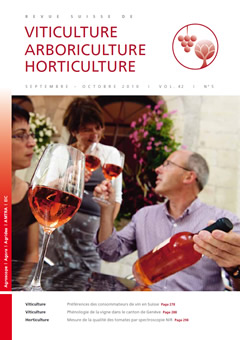
Issue 5 - September - October 2010
Abstract in open access
This article presents the results of a study on consumers' perceptions of wine in Switzerland. Using conjoint analysis, 401 people in eight different Swiss cities were surveyed in order to measure the relative importance of the attributes shaping consumer preferences for wine: price, country of origin, production system and colour. The most striking finding was the confirmation of the country of origin and price as the most important criteria in the purchase of wine. The results indicate that consumers fall into four groups in terms of wine-buying behaviour: the indifferents, the curious, the traditionalists and the internationalists.
Keywords: wine, consumers, survey, conjoint analysis, Switzerland
E-Mail: ali.ferjani@art.admin.ch
Adress:
Abstract in open access
Terroir studies are common nowadays but few have used precise pedoclimatic measures for evaluating precocity potential. This work aimed (i) to assess the effect of terroir main parameters (soil, climate and topography) influencing phenological vine development and (ii) to evaluate the accuracy of a geostatistic approach using a high number of existing plots (higher variability) to analyze the terroir parameters' impact. Results showed that the plots had different development timing for budbreak and during growing season. Both periods were not influenced by the same pedoclimatic parameters. This emphasizes that the influence of these parameters can vary during the growing season. Some parameters derived from a digital elevation mode, like modelized incoming radiations, seem promising for estimating the precocity potential of the different zones. Finally, the results showed that the observation of numerous vineyards of the practice is convenient to define terroir main factors, despite natural variability or human influence.
Keywords: phenology, mesoclimate, PCA, precocity potential, GIS, terroir
E-Mail: stephane.burgos@eichangins.ch
Adress:
Abstract in open access
The research station of Agroscope ACW initiates the development of a nondestructive method for measuring tomato quality by portable near infrared spectroscopy (NIR). The soluble solids content, firmness and two components of the background color L* and a* corresponding to the lightness and to the «red/magenta and green» axis were measured on 38 fruits chosen for their difference in maturity. Statistical models based on partial least squares regression method were developed to correlate NIR measurement with fruit quality. The results show that soluble solids content and firmness can be determined with an accuracy of 0.4 % Brix and 5 Durofel units. Regarding the determination of color components, models present particularly precise results with correlation coefficient values of 0.95 and 0.92 for L* and a*, respectively.
Keywords: NIR spectroscopy, tomato, quality, soluble solids content, firmness, background color
E-Mail: cedric.camps@agrocope.admin.ch
Adress:
Abstract in open access
Hyalesthes obsoletus Signoret (Hemiptera, Cixiidae) is the principal vector of bois noir in Switzerland, a grapevine yellows disease sharing identical symptoms with flavescence dorée. The nymphs of this polyphage insect develop mainly on the roots of viticultural weeds rather than grapevine, an inadequate food source for the vector. Aiming to better understand the epidemiology of bois noir in Swiss vineyards, we studied the host plant preferences of H. obsoletus. Our captures on different viticultural weeds indicate that the vector is mainly found on stinging nettles (Urtica dioica) in Switzerland, with the exception of the Valais. A survey to identify the origin of emergence also showed that H. obsoletus nymphs prefer to develop on stinging nettles. This plant thus plays a central role in the epidemiology of bois noir in Swiss vineyards, a fortiori, because infected vines are frequently located close to stinging nettle patches.
Keywords: viticulture, Vitis vinifera, phytoplasma, stolbur, plant-vector associations
E-Mail: patrik.kehrli@acw.admin.ch
Adress:
Abstract in open access
Viscosity and texture are important properties for liquid products. Many factors in wines influence these parameters (Nurgel and Pickering 2005): ethanol, sugar, glycerol or phenolic compounds. In sensory analysis, wine texture is translated by professionals with numerous attributes such as fluidity, volume, thickness, fat or astringency, which are essential criteria occurring in the gustative quality of a wine, but often defined by hedonic or not objective terms (structured, robust, etc.). In this work, the texture of some red wines was analysed with rheological and sensory methods. With an original approach, the aim was to compare the results obtained with these two methods and to correlate them. The intention was to provide professionals with some tools, which enable them to characterise objectively the texture of wines. Sensory results showed that astringency descriptors were able to discriminate the wines. «Geographical origin» and «wine maker» effects were revealed. The physical measurements (rheometers) also showed significant correlations with the intensity and the duration of the astringency as well as with the descriptor of the thickness. The interest in the rheological methods applied to the evaluation of the viscosity and texture of wines was demonstrated and a relation with astringency could be measured.
Key words: viscosity, texture, wine, sensory analysis, rheology.
Keywords:
E-Mail:
Adress: Agora

 Download of full issue
Download of full issue
 Download article
Download article